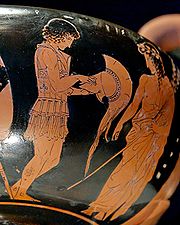
Eretria Painter
Encyclopedia


Ancient Greece
Ancient Greece is a civilization belonging to a period of Greek history that lasted from the Archaic period of the 8th to 6th centuries BC to the end of antiquity. Immediately following this period was the beginning of the Early Middle Ages and the Byzantine era. Included in Ancient Greece is the...
Attic
Attica
Attica is a historical region of Greece, containing Athens, the current capital of Greece. The historical region is centered on the Attic peninsula, which projects into the Aegean Sea...
red-figure
Red-figure pottery
Red-figure vase painting is one of the most important styles of figural Greek vase painting. It developed in Athens around 530 BC and remained in use until the late 3rd century BC. It replaced the previously dominant style of Black-figure vase painting within a few decades...
vase painter. He worked in the final quarter of the 5th century BC. The Eretria Painter is assumed to have been a contemporary of the Shuvalov Painter
Shuvalov Painter
The Shuvalov Painter was an Attic vase painter of the red-figure style, active between 440 and 410 BC, i.e. in the High Classical period ....
; he is considered one of the most interesting painters of his time. Many of hist best works are painted on oinochoai and belly lekythoi
Lekythos
A lekythos is a type of Greek pottery used for storing oil , especially olive oil. It has a narrow body and one handle attached to the neck of the vessel. The lekythos was used for anointing dead bodies of unmarried men and many lekythoi are found in tombs. The images on lekythoi were often...
. His paintings often depict many figures, moving in groups across all available surfaces. He also painted such vessels as figure-shaped vases or head-shaped kantharoi
Kantharos
A kantharos or cantharus is a type of Greek pottery used for drinking. It is characterized by its high swung handles which extend above the lip of the pot.The god Dionysus had a kantharos which was never empty....
. Much as the vase shapes he painted on are unusual, his themes are conventional: Athletes, satyr
Satyr
In Greek mythology, satyrs are a troop of male companions of Pan and Dionysus — "satyresses" were a late invention of poets — that roamed the woods and mountains. In myths they are often associated with pipe-playing....
s and maenad
Maenad
In Greek mythology, maenads were the female followers of Dionysus , the most significant members of the Thiasus, the god's retinue. Their name literally translates as "raving ones"...
s, and mythological scenes. There are also some careful studies of women. He also painted white-ground
White Ground Technique
White-ground technique is a style of ancient Greek vase painting in which figures appear on a white background. It developed in the region of Attica.-Technique and style:...
vases. A lekythos in New York shows a funeral scene, typical of white-ground painting: Achilles
Achilles
In Greek mythology, Achilles was a Greek hero of the Trojan War, the central character and the greatest warrior of Homer's Iliad.Plato named Achilles the handsomest of the heroes assembled against Troy....
is mourning Patroklos; the nereids bring him new weapons. The Eretria Painter's drawing style influenced later artists, e.g. the Meidias Painter
Meidias Painter
The Meidias Painter was an Athenian red-figure vase painter in Ancient Greece, active in the last quarter of the fifth century BCE . He is named after the potter whose signature is found on a large hydria of the Meidias Painter’s decoration , excavated from an Etruscan tomb...
and his school.

